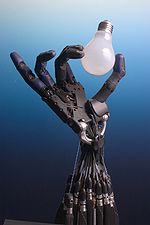Manipulator (device): Difference between revisions
m WP:CHECKWIKI error fix for #61. Punctuation goes before References. Do general fixes if a problem exists. - |
No edit summary |
||
| Line 1: | Line 1: | ||
{{Unreferenced|date=December 2009}} |
{{Unreferenced|date=December 2009}} |
||
In [[robotics]] a '''manipulator''' is a device used to manipulate materials without direct contact. The applications were originally for dealing with [[Ionizing radiation|radioactive]] or [[ |
In [[robotics]] a '''manipulator''' is a device used to manipulate materials without direct contact. The applications were originally for dealing with [[Ionizing radiation|radioactive]] or [[bioh.ials, using [[robotic arm]]s, or they were used in inaccessible places. In more recent developments they have been used in diverse range of applications including [[welding]] automation,<ref>{{Cite web|url=https://www.ljwelding.com/products/type/welding-manipulators/|title=Welding Manipulators {{!}} Subarc Welding & CMT Manipulators|last=Automation|first=LJ Welding|website=www.ljwelding.com|access-date=2016-09-26}}</ref> [[Robotic surgery|robotically-assisted surgery]] and in [[Robotic arm|space]]. It is an arm-like mechanism that consists of a series of segments, usually sliding or jointed called cross-slides,<ref>{{Cite web|url=https://www.ljwelding.com/https/www.ljwelding.com/products/type/accessories/cross-slides|title=Cross Slides|last=Automation|first=LJ Welding|website=www.ljwelding.com|access-date=2016-09-26}}</ref> which grasp and move objects with a number of [[Degrees of freedom (mechanics)|degrees of freedom]]. |
||
In industrial ergonomics a manipulator is a lift assist device used to help workers lift, maneuver and place articles in process that are too heavy, too hot, too large or otherwise too difficult for a single worker to manually handle. As opposed to simply vertical lift assists (cranes, hoists, etc.) manipulators have the ability to reach in to tight spaces and remove workpieces. A good example would be removing large stamped parts from a press and placing them in a rack or similar dunnage. In welding, a column boom manipulator is used to increase deposition rates, reduce human error and other costs in a manufacturing setting. |
In industrial ergonomics a manipulator is a lift assist device used to help workers lift, maneuver and place articles in process that are too heavy, too hot, too large or otherwise too difficult for a single worker to manually handle. As opposed to simply vertical lift assists (cranes, hoists, etc.) manipulators have the ability to reach in to tight spaces and remove workpieces. A good example would be removing large stamped parts from a press and placing them in a rack or similar dunnage. In welding, a column boom manipulator is used to increase deposition rates, reduce human error and other costs in a manufacturing setting. |
||
Revision as of 18:54, 27 November 2016
In robotics a manipulator is a device used to manipulate materials without direct contact. The applications were originally for dealing with radioactive or [[bioh.ials, using robotic arms, or they were used in inaccessible places. In more recent developments they have been used in diverse range of applications including welding automation,[1] robotically-assisted surgery and in space. It is an arm-like mechanism that consists of a series of segments, usually sliding or jointed called cross-slides,[2] which grasp and move objects with a number of degrees of freedom.
In industrial ergonomics a manipulator is a lift assist device used to help workers lift, maneuver and place articles in process that are too heavy, too hot, too large or otherwise too difficult for a single worker to manually handle. As opposed to simply vertical lift assists (cranes, hoists, etc.) manipulators have the ability to reach in to tight spaces and remove workpieces. A good example would be removing large stamped parts from a press and placing them in a rack or similar dunnage. In welding, a column boom manipulator is used to increase deposition rates, reduce human error and other costs in a manufacturing setting.
Additionally, manipulator tooling gives the lift assist the ability to pitch, roll, or spin the part for appropriate placement. An example would be removing a part from a press in the horizontal and then pitching it up for vertical placement in a rack or rolling a part over for exposing the back of the part.
Specialized types
One of the types of manipulators is balanced manipulator type MSP-250, controlled by the operator's hand. Such manipulators are used in various industries. Where there are special requirements to protect against fire and explosion, they may be driven by compressed air.
A welding manipulator can be either open arc or submerged arc. A welding manipulator can be used to weld horizontally and vertically and is ideal for job shops as they are robust, have high production volume capacity and a greater degree of flexibility in product engineering. Welding manipulators are commonly used in pipe and vessel fabrication[3] but can be used in a cladding procedure with the aid of a proper welding fixture.
Examples
Examples of robotic manipulators are:
- Canadarm
- Terabot-S by Oceaneering Space Systems
- SCARA
- da Vinci Surgical System
See also
- ANAT Technology (Articulated Nimble Adaptable Trunk)
- Industrial robots
- Robotic arm
- Telemanipulator
References
- ^ Automation, LJ Welding. "Welding Manipulators | Subarc Welding & CMT Manipulators". www.ljwelding.com. Retrieved 2016-09-26.
- ^ Automation, LJ Welding. "Cross Slides". www.ljwelding.com. Retrieved 2016-09-26.
- ^ "Thinking about submerged arc welding? - The Fabricator". www.thefabricator.com. Retrieved 2016-09-26.
